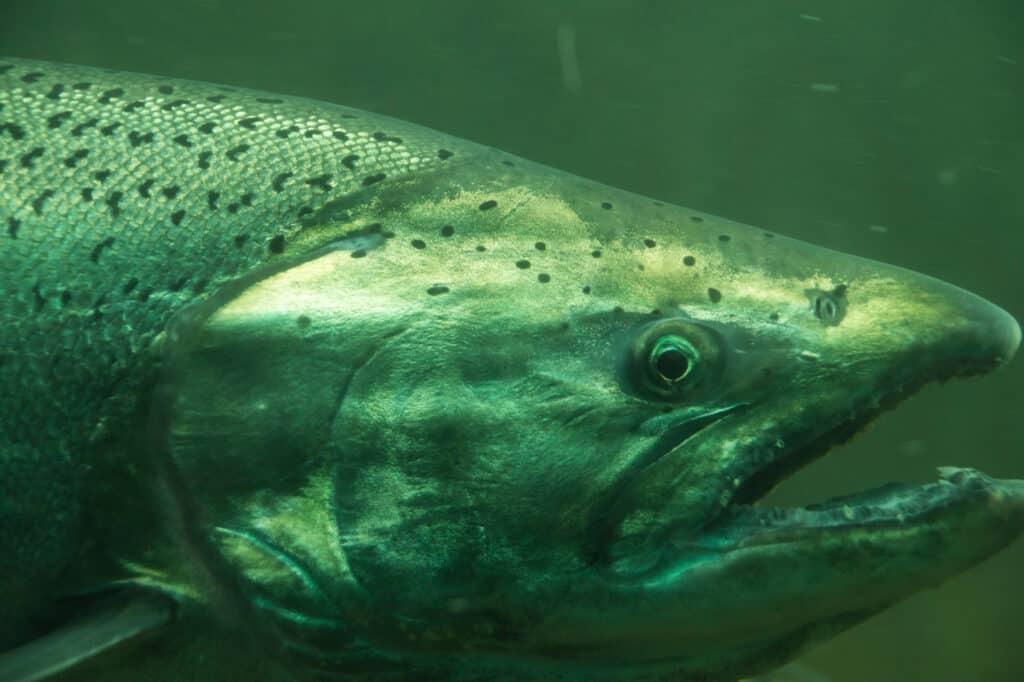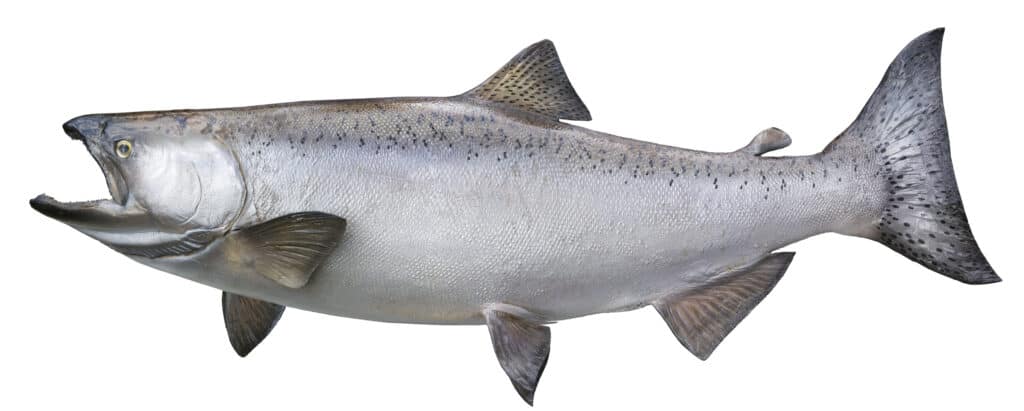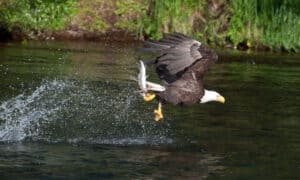Their name says it all — king salmon take up the most space of all salmon and are one of the greatest prizes for recreational fishermen. These fish are named such because of their important interrelation with indigenous people, who spoke the Chinookan language. These fish made up an integral part of their diet, serving as sustenance. Even as king salmon die, their bodies become the nutrients other organisms require to thrive. Discover the largest king salmon ever caught in Idaho, learn a bit more about this large fish, and how to catch one if you head out on a fishing trip!

The king salmon is a beautiful silver-colored fish.
©vladdon/Shutterstock.com
King Salmon Overview
King salmon, also referred to as chinook salmon grows to be the largest of the different types of salmon. Typically, August and September are the months when spring and summer chinook spawn. The young king salmon stick around Idaho for about a year before they migrate come spring and summer seasons again. Their preference for breeding includes freshwater streams and rivers.
Most king salmon spend around two or three years out at sea once they get there, making their way up to the Gulf of Alaska. But some may spend a whole five years out in the ocean. In the fall, king salmon spawn again during October and November. They use several rivers including the Snake, Salmon, and Clearwater Rivers, and again, remain in these waters for several months before they set out on the migratory journey to the ocean. These chinook salmon don’t go as far into the ocean as their counterparts from earlier in the year and instead call the coast their home.
Expected Size of King Salmon
King salmon grow the largest of all salmon and their expected size, on average, is about 38 inches long and between 25 and 30 pounds. These fish are found in Alaska and a couple of other states in the contiguous U.S., including Oregon, Idaho, Washington state, and California. They gravitate to the Northern Pacific Ocean and are a favorite for many recreational fishermen. These are fleshy fish with a distinct flavor and are versatile, as they can be cooked using a variety of methods.

They gravitate to the Northern Pacific Ocean and are a favorite for many recreational fishermen.
©Dan Thornberg/Shutterstock.com
King Salmon Fishing Basics
King salmon are large fish and make a great prize for anglers because of the fight they put up, the thrill they offer, and the tasty, delightful meal they eventually make. Typically, it’s the region between northern California to Alaska that attracts anglers looking to catch king salmon. It’s been the focus of fisheries management to ensure western reservoirs and lakes have a fresh supply of salmon headed toward the ocean so they can live out their lives within freshwater as well.
Type of Rod
They’re aggressive fish, which only excites a good fisherman. You may be on the lookout for another type of salmon but either way, you need a sturdy, long rod. When you’re in the rivers, you need that space, but you still need a solid backbone to reel it in. It also depends on where you’re casting from to ensure that you develop an appropriate technique. Boat rods may be shorter, but bank rods should be at least eight feet. In terms of location, river fishing from a bank may be most beneficial for your wallet. You have good access, but you don’t require a dedicated fishing boat.
Spinners, Spoons, and Casting
Use spinners and spoons when you’ve identified the correct region for your trip. A chinook salmon responds well to a large casting style and you’re working with shallower waters (less than five feet deep). Look for soft currents and backwater eddies when you’re working with a spinner. Spoons can render a high yield and this part is ultimately going to depend on your preference. If you can find one that looks kind of like a hefty, injured fish, you’re good to go. You want to bring out the aggression of salmon and this option works well. Wobblers are better for salmon in deeper waters and if you venture into saltwater, follow the birds!

Typically, it’s the region between northern California to Alaska that attracts anglers looking to catch king salmon.
©Rocksweeper/Shutterstock.com
Largest King Salmon Catch in Idaho
The largest king salmon catch happened on September 13, 1987, in Coeur d’Alene Lake. Jane Clifford pulled in a freshwater chinook salmon that weighed 42 pounds, measured 41.25 inches, and had a girth of 29.75 inches. The largest ocean-run chinook salmon weighed 54 pounds and was caught in 1956 by Merrold Gold in the Salmon River. There was a more recent catch in Coeur d’Alene Lake by Larry Masuda of Post Falls who caught a chinook salmon that weighed 32.46 pounds (not nearly as impressive as Clifford’s catch), was 38 inches long, and had a girth of 27 inches.
Largest King Salmon Catch in the World
Although in Idaho, 42 pounds was record-breaking, the largest chinook salmon ever caught weighed an astonishing 126 pounds! This was a commercial catch near Petersburg, Alaska in 1949, rivaled only by a sports record catch of 97 pounds by Les Anderson of Soldotna.
Where Is Coeur d’Alene Lake Located on a Map?
Coeur d’Alene Lake is the second largest lake in northern Idaho that is more than 26 miles long with some 135 miles of shoreline. This natural lake is fed primarily by two rivers, the Coeur d’Alene River and St. Joe River, and its outlet forms the Spokane River.
The photo featured at the top of this post is © The Old Major/Shutterstock.com
Thank you for reading! Have some feedback for us? Contact the AZ Animals editorial team.






